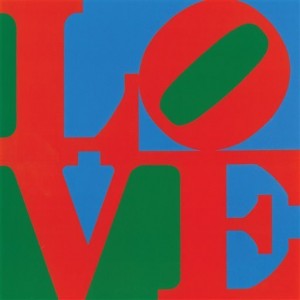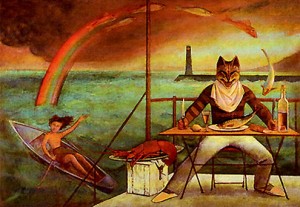
01 Oct TIO NYC: Museum Wrap – or Rap
 A funny thing happened on the way to the Chagall show at the Jewish Museum. The door to the artist’s darker works – read not all fiddlers on the roof and weightless couples free-floating “Gravity”-style in space – were slammed shut because of the Jewish holiday of Simchat Torah, a celebration of the conclusion of the annual cycle of public Torah readings and the beginning of a new cycle. (In Orthodox and many Conservative congregations, this is the only time of year Torah scrolls are taken out of the ark and read at night.)
A funny thing happened on the way to the Chagall show at the Jewish Museum. The door to the artist’s darker works – read not all fiddlers on the roof and weightless couples free-floating “Gravity”-style in space – were slammed shut because of the Jewish holiday of Simchat Torah, a celebration of the conclusion of the annual cycle of public Torah readings and the beginning of a new cycle. (In Orthodox and many Conservative congregations, this is the only time of year Torah scrolls are taken out of the ark and read at night.)
We would have loved to have seen the Chagall. The show is filled with images created during a significant, but largely neglected, period in the artist’s career. The work covers the rise of fascism in the 1930s, on through 1948, years spent in Paris and then in exile in New York. Apparently the exhibition somewhat surprisingly features lots of JCs on a cross, clearly a universal symbol for Chagall of a persecuted people, the suffering of the martyred figure twinned by the artist with the horrors of the Holocaust.
 We would have relished the intensity of Chagall’s riotous palette – Picasso revered him as a colorist – his flaming oranges and ice-cold blues – but it was not meant to be. Instead we trucked down the road a piece to the Whitney Museum to view the works of Pop icon Robert Indiana (born 1928) on the opening day of the blockbuster.
We would have relished the intensity of Chagall’s riotous palette – Picasso revered him as a colorist – his flaming oranges and ice-cold blues – but it was not meant to be. Instead we trucked down the road a piece to the Whitney Museum to view the works of Pop icon Robert Indiana (born 1928) on the opening day of the blockbuster.
“Beyond Love” – “LOVE,” the work fashioned by the artist (in 1966) with the tilted “O” to suggest Indiana’s ambivalent (at best) feelings about that ineffable emotion – went viral, becoming an emblem of sexual freedom for the era.
That was the good news.
And the bad news.
The mass production of the image in 2- and 3-D ultimately destroyed Indiana’s reputation in the New York art world – also the center of international art world at the time. (The artist in despair flew the coop to Maine, where he lives today.)
 “Beyond Love,” the artist’s first retrospective in the United States, surveys Indiana’s 60-year career as a Pop star, an honor he shared with like-minded iconoclasts such as Andy Warhol, Claes Oldenburg, Roy Lichtenstein and James Rosenquist.
“Beyond Love,” the artist’s first retrospective in the United States, surveys Indiana’s 60-year career as a Pop star, an honor he shared with like-minded iconoclasts such as Andy Warhol, Claes Oldenburg, Roy Lichtenstein and James Rosenquist.
Indiana manipulated a vocabulary of highway signs and roadside entertainments, combining words and images to create boldly in-your-face and visually kinetic art. The surface optimism of the images, however, belies a darkness that pervades Indiana’s biography. He was adopted by Earl and Carmen Clark and his turbulent childhood in the Midwest was marked by financial instability, yearly moves, and divorce when he was eight. Indiana was gay when the world was far less accepting. The hard-edged graphics and declarative text also provide a running commentary on American myths, history and literature, both a critique and a celebration of the country’s post-war culture: his Confederacy Series, which inveighs against racial injustice, is particularly powerful.
The New York Times raved about the show. For the review, read here.
For us, Indiana’s visual keening appealed more to the head than to the heart. Yes, the show is smart and slick, hard-edged and polychromatic, but for a gut punch, we returned to the Hopper show in the same museum two floors below. The master of stillness and loneliness overwhelms the emotions while confounding the mind. (How did he he do it?) Hopper dazzles – without trying so hard.
And, if the marriage of image and text is your thing, if you applaud attacks on the bourgeois values Pop artists like Indiana held up to ridicule, Magritte was there first. See his show at Museum of Modern Art. And talk about iconic imagery: Magritte’s endlessly popular work has shown up (to date) on a Beatles record label, in a Volkswagon ad, bowler-hat light fixtures, even a Tumblr called Super Magritte.
See related posts on Magritte and Hopper.
(Chagall at the Jewish Museum through February/2/2014. Indiana at the Whitney through January/5/2014)
Balthus “Cats and Girls” at the Met
 Julia Margaret Cameron’s incisive portraits pierce the soul of each sitter, but just down the hall is another entirely different portrait show of intimates: “Balthus Cats and Girls.” The 35 works from the 1930s – 1950s are as visually compelling and emotionally moving as they are disturbing. A seething serenity pervades the work depicting the artist’s harem of Lolitas by other names: his first model, Therese Blanchard, a young neighbor in Paris; a variety of nymphets in Switzerland; then Frédérique Tison, his favorite model, at the Château de Chassy in the Morvan during the 1950s. But the paradox makes sense because all young girls (and most cats) make little sense: in repose dreaming or reading one minute; in an estrogen-fueled frenzy the next. We are voyeurs witnessing through Balthus’s canvases a seductive calm before the storm.
Julia Margaret Cameron’s incisive portraits pierce the soul of each sitter, but just down the hall is another entirely different portrait show of intimates: “Balthus Cats and Girls.” The 35 works from the 1930s – 1950s are as visually compelling and emotionally moving as they are disturbing. A seething serenity pervades the work depicting the artist’s harem of Lolitas by other names: his first model, Therese Blanchard, a young neighbor in Paris; a variety of nymphets in Switzerland; then Frédérique Tison, his favorite model, at the Château de Chassy in the Morvan during the 1950s. But the paradox makes sense because all young girls (and most cats) make little sense: in repose dreaming or reading one minute; in an estrogen-fueled frenzy the next. We are voyeurs witnessing through Balthus’s canvases a seductive calm before the storm.
Bathus’s beloved cats are alternately avatars for sleek, sensuous young women or as hip cats, surrogates for the mischievous artist (those are vintage Cheshire Cat). One of the best of them is a self-portrait of the artist with a feline head, on loan from the Paris restaurant where the painting hangs today.
The Balthus show also includes a series of 40 small ink drawings for Mitsou, in which the eleven-year-old prodigy evoked his adventures with a stray tomcat, eventually published by the German poet Rainer Maria Rilke in book form in 1921. This is the first time that charming work has ever been seen in public
“Cats and Girls” is the first exhibition of the Balthus’s works in this country in 30 years.
Go because you can. Stay because you can’t look away.
(Through January 12, 2014.)


Sorry, the comment form is closed at this time.